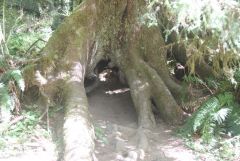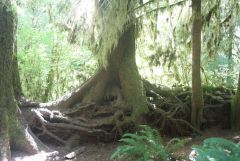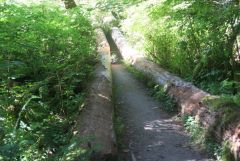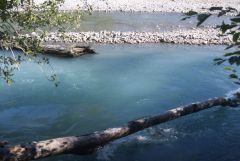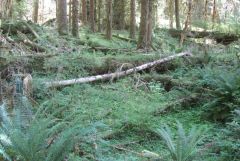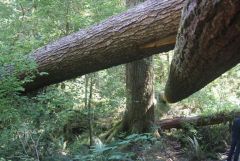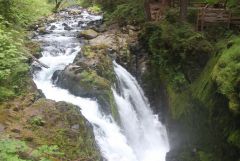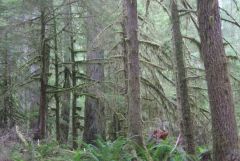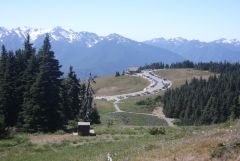-
Content Count
2713 -
Joined
-
Last visited
-
Days Won
44
Content Type
Profiles
Forums
Blogs
Gallery
Everything posted by tbutler
-
From the album: Olympic National Park
This tree demonstrates the effect that you get with the tree standing up on its roots. The nurse log has completely rotted away and now the tree stands up above ground level.© @TBUTLER
-
From the album: Olympic National Park
The fallen trees in the forest become nurse logs, providing a place for other trees to sprout. These trees grow on top of the nurse log and can often be seen with their roots straddling the nurse log. Once the nurse log rots away, the roots remain as a frame for the now missing nurse log. As a result the tree trunk at its base is well above ground with the roots holding it firm even though they are several feet above ground.© @TBUTLER
-
From the album: Olympic National Park
Here a pair of fallen logs frame the Spruce Trail in the Hoh Rainforest. Two trees blown down lay parallel so the trail builders routed the trail between these two logs. Seeing logs lying on the ground like this demonstrates how tall these trees are.© @TBUTLER
-
From the album: Olympic National Park
The Hoh River flows from the western side of Olympic National Park. Much of its water comes from melting glaciers on the peaks of the Olympic Mountains. This glacial water contains fine powdered rock formed by the grinding action of the glacial ice against rocks. When the glacier melts the rocks in the glacier wash downstream piling up in gravel bars in the river channel. The fine powdered rock gives the water its milky appearance. All glacial streams have this milky appearance.© @TBUTLER
-
From the album: Olympic National Park
One more look at the forest floor covered with fallen trees. These logs are covered with moss which is everywhere in the temperate rainforest of the western slopes of Olympic National Park.© @TBUTLER
-
From the album: Olympic National Park
Another view of the forest floor and the downed trees.© @TBUTLER
-
From the album: Olympic National Park
The forest floor is covered with logs from trees which have been blown down by winter storms. Wind speeds in excess of 100 miles per hour are experienced in some of these storms. The amount of rain received in the Olympic National Forest keeps the forest wet enough to prevent most forest fires. The fires that do burn are usually small in area and are easily extinguished by additional rains. People refer to the forest here as being the asbestos forest. As a result logs of threes which have been blown down litter the understory of the forest. These logs will provide a nursery for trees to grow on, taking their nutrients from the decaying fallen log.© @TBUTLER
-
From the album: Olympic National Park
Sol Duc Falls is one of the premier waterfalls in Olympic National Park. Here the Sol Duc River drops into a chasm created by erosion along a zone of weakness in the rock.© @TBUTLER
-
From the album: Olympic National Park
Another of the small streams, this one creating a stair step waterfall.© @TBUTLER
-
From the album: Olympic National Park
This is typical of the shorter trails in Olympic National Park. These are busy trails during the summer season. As the rainy season arrives in October, the trails will be quieter.© @TBUTLER
-
From the album: Olympic National Park
I suggested to Louise that we should have a fountain like this in our garden at our home in Texas. Even in the dry season water trickles down everywhere.© @TBUTLER
-
From the album: Olympic National Park
This is a mature stand of Douglas fir and hemlock. Along with Sitka spruce, red alder and maple trees these compose most of the large trees in the forests of Olympic National Park. One of the challenges of photographing these monster trees which grow to heights of 250 to 300 feet is to get the whole tree in a picture.© @TBUTLER
-
From the album: Olympic National Park
Where light penetrates to the forest floor small trees will sprout and grow. With a solid upper story of trees shading most of the forest floor, growth remains sparse. One of the delights of walking through these forests was the vast array of shades of green.© @TBUTLER
-
From the album: Olympic National Park
The Hurricane Ridge Visitors Center provides the best view of the interior mountains of the Olympic Range that is accessible by road. To see more you have to hike into the interior.© @TBUTLER
-
That is about what I would have said. I would suggest remodeling for interior issues. I have even heard of RV shops that will install a slide out if you want another one. I can't vouch for the nature of this work but it could be investigated. I know that it isn't a big issue to change the couch to a recliner. Handling issues might be improved with after market add on devices, maybe not. We have already embarked on remodeling our coach. Last year we replaced all the window shades and installed a residential refrigerator. When our water heater gives out I'll install a tankless model. I'll have the ceiling and all interior lighting modified in coming years as the price of LED lights becomes more reasonable. I plan to keep this motor home for a long time. I can't imagine ever purchasing another. These things are expensive! If you want to change motor homes, consider waiting until your use of the motor home changes, like when you retire and decide to go full time or even half time in your motor home. By then there will be unimaginable improvements and you will want a new motor home anyway.
- 5 replies
-
- diesel
- dutch star
-
(and 7 more)
Tagged with:
-
Look about 1000 miles west. The southern tip of Texas has many RV parks and the rates are reasonable. Before we took a mobile lot, we were paying less than $2500 for an annual contract on a site. The monthly rate was less than $400 plus the cost of electricity. Our park has a heated pool, tennis courts, shuffleboard courts, petanque courts, a regular schedule of activities from social card games to bike rides, motorcycle rides, golf, bowling, dances, musicals and plays, etc. The area is a birding hot spot with many birds from south of the border that are seen nowhere else than along the Rio Grande. The same is true of butterflies. Both these bio resources attract international visitors. Our latitude is about the same as Ft. Myers. The natives are glad to see you. We are adopted by the locals and are called Winter Texans. If you want to be on the coast, there are campgrounds there, we're further inland but the coast is within 2 hours drive. We have shopping malls, all the usual chain food restaurants in abundance. We also have a host of genuine Mexican restaurants, and a full complement of other ethnic restaurants. There are golf courses with rates in the $30 per 18 holes including golf cart. RV parks range from the really basic and inexpensive to full resort facilities with broad activity programs at many RV parks.
-
We have been on the Olympic Peninsula for just over a month now. Starting on the east side of Olympic National Park and moving north, west and now south we have explored the fringes of this vast wilderness park. We have also explored the towns and villages surrounding the park. There are so many things we have seen and done that I won't even begin to write about all of them in one entry. I'm starting with nature because that is the focus of the national park. We have walked many miles of trails over the hills and through the forests of Olympic National Park. I always have my camera with me and I take pictures as if they were free because they actually are since the dawn of digital cameras. After you purchase the camera it costs you no more to take 10,000 pictures than it does to take one. So we return from an outing and I download two or three hundred pictures. We were walking a trail in the Hoh Rain Forest on the western slopes of the Olympic Mountains. Here rain falls in annual amounts in excess of 100 inches. Summer is the dry season so the trails were dusty and no water dripped from the leaves of the trees. By the end of September, this will end and rain will start to fall. Higher in the mountains it will be snow and there are active glaciers on the peaks of the Olympic Mountains. The Hoh River has a bluish color associated with the color of rock flour, formed as glaciers grind rock into a fine powder. This is released as the glacier melts during the summer. As I walked the trail and snapped picture after picture something dawned on me. I am constantly frustrated because my camera isn't large enough. The trees are up to 300 feet tall. It fascinates me to look up at these monsters towering far above my head. But it isn't just one tree, it is a whole forest of trees. I can turn left, right all the way around and I am surrounded by incredible scenery. With my little camera I get a bit here, a bit there. I can digitally stitch pictures together to get panoramic pictures. But there is no way that I can convey the splendor of what I am actually seeing. It is impossible to put nature in a box. I've seen the redwoods of Northern California and the sequoias of Sequoia National Park. The Douglas fir trees, Hemlocks, Sitka spruce, red alder and maple trees of the Olympic Peninsula are no less amazing. The forest here on the western slopes is known as the asbestos forest because it seldom burns. There is enough rain and moisture that the forest is very difficult to set on fire. Most of the trees in the national park are destroyed by wind. Hurricane Ridge in the park gets its name from the ferocious winds that blow here during winter storms. Winds in excess of 100 miles per hour bring down trees, laying them out across the forest floor. Root balls 20 feet tall are raised as a huge tree rips its roots from the ground. The forest floor is littered with monster logs piled up across other logs. With the wet conditions, every inch of the forest floor grows something. When a log falls to the forest floor, it becomes fair game. Mosses grow and cover the downed tree. Other trees sprout on top of the log. Such logs are known as nurse logs because they feed the life growing on them. Over time the roots of young trees grow down around the log into the ground. Over time the nurse log eventually rots away and leaves a void beneath the young tree. The roots that once framed the nurse log before it rotted away now are well above ground with a void beneath. The tree towers above these roots as if the tree is standing on its tip toes. So I have pictures of the roots of such trees. I have pictures of mosses draped from limbs of trees, covering logs, growing on the ground. I have pictures of streams, waterfalls, rapids. They can be 4 x 6 snapshots, 8 x 10 pictures, 20 x 30 posters or wall size murals Whatever they are, they are flat, two dimensional representations of nature, Putting nature in a box, no matter how pretty it looks, just doesn't convey anything close to the real experience. So enjoy the pictures but you really have to come see this for yourself.
-

Hurricane Causing Change Of Vacation Plans
tbutler replied to neilcarol's question in Destinations/Attractions
Why not head straight south along the Mississippi? Besides Memphis, you could stop at Natchez and spend a few days touring some of the antebellum homes. That should keep you west of the anticipated path of the hurricane. Your appointment may be postponed as Alabama is predicted to be pretty close to ground zero for this storm. It is not uncommon to have areas near landfall out of commission for days after a hurricane. Do keep your eye on the forecast. New Orleans is still on the fringe of the cone of certainty. You don't want to be anywhere near the hurricane. Tiffin will understand. Oh, yes, don't forget to stop for some throwed rolls at Lamberts in Sikeston! -
I can see from the current forecast that the forecast path of the storm is just off the west coast of Florida. They've gotten really good at predicting the course of these violent storms. You still need to watch the forecast as they are constantly revising the predicted path based on later information. Remember just a few days ago they were forecasting it would go over Cuba, not north of Cuba. Even if it is off the coast, you will be in the fringes of a category 1 or perhaps category 2 hurricane. The thunderstorms associated with a hurricane are fierce, they spawn tornadoes as well as severe winds, incredible lightening and damaging hail. These can happen well outside the eye of the storm. The storm surge associated with hurricanes has moved ocean going vessels miles inland, parking them on high and later dry land. Ten, fifteen inches of rain can cause unbelievable flooding as rivers are backed up from the increased height of the ocean due to the storm surge. If you have the means to get away, that is what you should do. I would not take a chance on being anywhere hear a hurricane if I had the means to get away. As said above, if you aren't moving your coach, take the toad and head north and up the east coast of Georgia until the storm passes. At least then you will have your family and a few possessions. You can go see what is left of your motor home later. Evacuation requires that you leave now. Every minute you delay will slow your escape as you become entangled in the traffic of others who are leaving.
-

New Rig For Trip-- Portland, OR To Denver
tbutler replied to Larry196's question in Destinations/Attractions
So is your dealer in Portland? I agree with those above, stay close to home for a week or two and give the rig a run through so you can find any things that need fixing and get back to the dealer with a list while your money is still warm in their pockets! You dealer is going to offer the best response to your needs. Getting repairs and further instruction on operation of your rig will be harder to come by once you are on the road. As said above, move from campground to campground several times, set up, take down. Boondock overnight to see how the inverter/batteries/generator work. Do some mountain driving to test the acceleration and the braking including the engine braking. Get a feel for the handling and operation. Fill the fuel tank, empty the waste tanks, try the on-air TV antenna and your satellite dish if you have one. Give the plumbing a run, wash a load of laundry or two in the washer if you have one. You get the idea. There are lots of things to test before you really leave home. I just re-read your post and you are in Vancouver, WA. Duh! You already know all this but anyway here is what I was saying... Just east of Portland is a wonderland of waterfalls. All along the southern edge of the Columbia River Gorge are waterfalls coming off the northern slope of Mount Hood. You can see them driving your toad along the old highway. You will be stopping every 5 to 10 miles and driving through some great scenery as well. If you are so inclined, several of the dams in the gorge offer tours. Mount Hood itself is worthy of a day or two of exploration. This time of year you can drive up to the ski lodge and even take the ski lift and play in the snow for a while. We camped at Dallesport on the Washington side of the river but I can't find a reference for the park. There is a state park there which accommodates big rigs. There are other locations in the vicinity where you could stay. Further east in Washington we love the area around Grand Coulee Dam and Coulee City, WA. We also recently explored Yakima, WA and found some interesting stops there. All these are within driving distance of Portland so you could make a run at these locations and then stop back at the dealership with your list of fixes. You could also call them as the list is taking shape and make an appointment so you could get in and out with dispatch. In the long run you may save yourself a lot of time. Here are other options for close to home travel. You could come up north where we have been for the past month, spend some time poking around the Olympic Peninsula then head back to Portland. We also love the area around Mt. Ranier and Mt. St. Helens. On south into Oregon Crater Lake is fun to explore. On down the road, once you are comfortable leaving the dealership... Here is one route with several stops to explore. Start in S central Idaho, Carters of the Moon National Monument, Yellowstone Natonal Park, The Grand Tetons in Wyoming, drive the east side of Flaming Gorge Reservoir to Vernal Utah - Dinosaur National Park. We loved the drive from Vernal into Denver on old Hwy 40. You will have two choices for mountain driving into Denver. You can jump south to I-70 and take that run into Denver or you can stay with 40 and take a more scenic route but it has some switchbacks before you finally join I-70 for the final descent. By far the easiest way to Denver from the west and over the Rockies is I-80 in Wyoming to I-25 but the other routes are much more interesting. Of course by this time you are coming to the season when you have to begin to think carefully and watch the weather report when it comes to mountain driving. -
We were without TV once. Out in the middle of nowhere, Nebraska with no on air signal. We were in a state park and there was no cable feed. On top of that we were parked under a big tree and we couldn't get a thing with the KVH dish. Before the two day stay ended I ran out of liquor and was chewing on the tires! I've learned to ask if we can have a nice clear sky site for DirecTV.
-
Where are you located? If in a northern state, you need to consider the effect of the freeze thaw cycle. If in certain southern states, insects like fire ants and termites might make it better to do a complete pad. Local concrete contractors should be able to advise you on how best to build in your particular area. What works in one area may not work in another area. To get an idea of the quality of work you want done, before you talk to a contractor, consider the following questions. What are the chances that you might move in the future? Are you interested in a pad that will last you for 5 years or 10 years or more? Is there a chance you might purchase another motor home? If that motor home is longer or shorter will that require doing some or all of this pad over?


